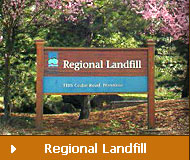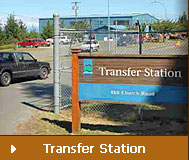Environmental Protection Programs
Regional Landfill - Environmental Protection Programs
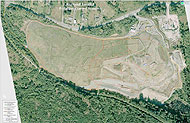 |
| An aerial view of the Regional Landfill showing the leachate and landfill gas collection systems. [ Click Here ] to enlarge |
The Regional Landfill's Environmental Protection Programs reflect a comprehensive approach to monitoring, evaluating and assessing the impacts of landfill operations on the environment. Measures are in place to reduce and manage impacts to groundwater, surface water, leachate and air quality. Environmental monitoring programs are conducted at the site to evaluate the following areas:
 |
| A high density double plastic liner was installed as part of the leachate containment system in a portion of the Regional Landfill that began receiving waste in 2005. |
When solid waste decomposes it produces leachate, which is accelerated by the percolation of water through the landfill.Landfill leachate is a complex mixture of organic and inorganic compounds produced from refuse materials by a combination of physical, chemical and biochemical processes.The Regional Landfill has an extensive leachate containment system, consisting of a high-density plastic liner and perforated pipes to collect leachate for treatment at the regional sewage treatment plant.
Leachate monitoring events regularly conducted include inspection of landfill slopes for leachate breakouts, sampling of leachate for chemical analysis, and measuring leachate elevations in the refuse mass. These tests are important for determining impacts to surface and groundwater, mitigating odours and monitoring for leachate mounding. The chemical analysis is also a requirement by the Ministry of Environment and the RDN Liquid Waste Department. Provincial regulations include "The Landfill criteria for Municipal Solid Waste (June 1993)" and "Guidelines for Environmental Monitoring at Municipal Solid Waste Landfills (January 1996)".
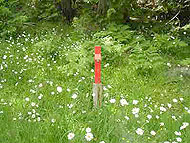 |
| A groundwater sampling well. |
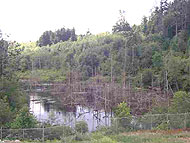 |
| Wetlands located at the Regional Landfill are monitored for impacts from storm water run-off. |
Migration of leachate from the landfill can affect ground and surface quality. The Regional Landfill's groundwater, surface water, and residential groundwater well monitoring program is designed to ensure landfill operations do not adversely affect water quality.The water quality monitoring program consists of the collection and analysis of groundwater and surface water samples.
Groundwater monitoring wells are located along the perimeter of the site for the purpose of monitoring groundwater quality at the property boundary. Surface water monitoring sites are also located around the perimeter of the site at streams and ditches.
Water samples are analysed for various physical parameters, geo-chemical indicators, dissolved metals and dissolved inorganics. This program is useful for determining if leachate is migrating off the site and potentially impacting neighbouring water bodies and aquifers.
 |
| A landfill gas collection well. |
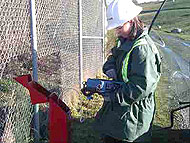 |
| Soil gas sampling. |
Landfill gas is generated as a result of the biological decomposition of organic waste material. In general it is composed of 50% methane and 50% carbon dioxide by volume. Landfill gas migrates through the landfill cover or adjacent soil and enters the atmosphere. Potential impacts from landfill gas include:The landfill gas collection system is designed to extract the majority of landfill gas produced and combust it at the flare station thereby reducing the above noted impacts. To monitor for gas migration off the site, soil gas probes are located at the landfill site perimeter where gas composition is regularly monitored.'
- Greenhouse gas issues
- Health and toxic effects
- Nuisance odour
- Explosive hazard; and
- Vegetative stress
Landfill Post Closure Plan
 |
| A conceptual plan showing how after closing the Regional Landfill will be used as park. [ Click Here ] to enlarge. |
The RDN has prepared a detailed plan for closure and post closure of the Regional Landfill, which has been approved by the BC Ministry of Environment and the Regional Board. Funds are being set aside for closure and monitoring costs and post-closure plans to rehabilitate the site as a community resource.After closure of the landfill, the RDN must operate and maintain pollution mitigation programs and infrastructure for at least 25 years. Active areas of the site will be capped with a clay cover. A layer of soil will be added to support vegetation and trees and shrubs planted to protect the clay cap layer and landscape the site. Landfill gas and leachate collection and environmental monitoring programs will continue to operate.
In 2004, RDN has completed a study of post-closure options for the Regional Landfill. After consulting with the community in the vicinity of the landfill and City of Nanaimo municipal staff, creation of a park was identified as the preferred post-closure use. The park would include open areas for recreation opportunities, plantings that enhance wildlife habitat and provide a nature experience for users, hiking trails that integrate into the surrounding area's trail network, and picnic areas and scenic viewpoints. As the landfill will continue to operate for a number of years, it is proposed that the park will initially be developed on the closed and capped 9-hectare area of the old landfill.

